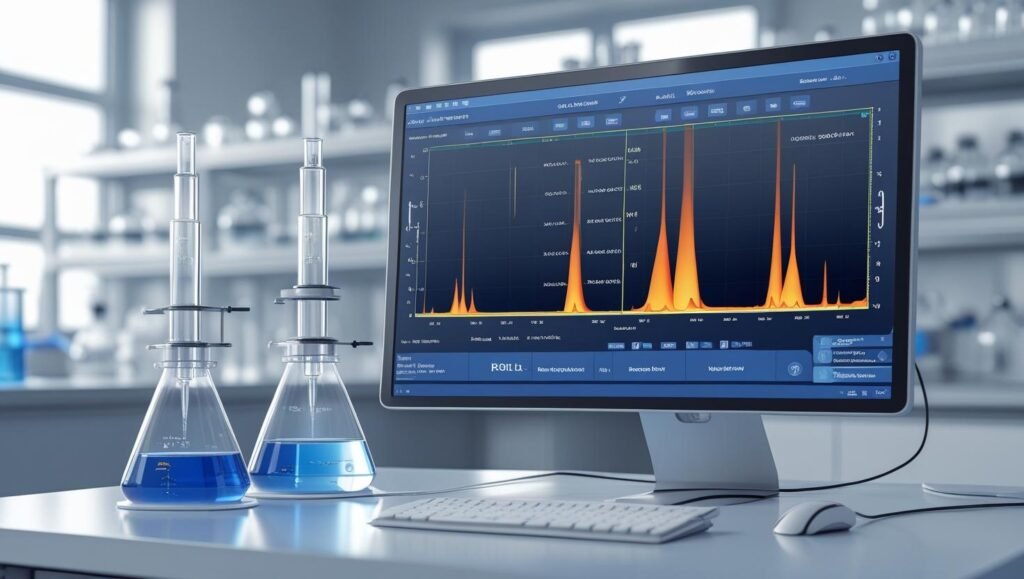
Trp oxidation in therapeutic peptides isn’t just a chemical nuisance—it’s a $2.3M remediation risk per FDA warning letter. When a single oxidized tryptophan residue in a GLP-1 agonist escaped detection during stability testing, it triggered immunogenic reactions in Phase III trials, erasing eight years of R&D investment. This incident epitomizes the high-stakes challenge of peptide impurity profiling: Traditional HPLC methods fail to resolve critical oxidation products hiding beneath primary peaks, leaving manufacturers vulnerable to costly regulatory setbacks. Modern peptide therapeutics demand next-generation analytical approaches capable of detecting Trp-oxidation impurities at ≤0.05% levels. This article examines breakthrough HPLC configurations—from focused gradient designs to multidimensional separations—that finally deliver the sensitivity, resolution, and throughput required for cGMP-compliant oxidation control in peptide APIs.
The Trp-Oxidation Crisis: Why Conventional Methods Fail
Tryptophan’s indole ring ranks among biology’s most oxidation-prone structures, with methionine and cysteine being the only residues more vulnerable. In therapeutic peptides, Trp oxidation causes:
- Potency Loss: Oxidized-Trp residues exhibit 70–90% reduced receptor binding affinity in GLP-1 analogs.
- Immunogenicity Risk: Carbonyl groups on oxidized Trp form neo-epitopes increasing immunogenic potential by 200%.
- Structural Destabilization: HydroxyTrp derivatives disrupt hydrophobic core formation in folded peptides.
Standard ICH Q3B-guided HPLC methods using trifluoroacetic acid (TFA)/acetonitrile gradients struggle with three analytical blind spots:
- Co-elution of Trp-oxidation products with main API peaks.
- Insufficient sensitivity for ≤0.1% impurity quantification.
- Inability to resolve positional isomers of oxidized Trp.
A 2024 industry benchmark revealed that 68% of failed peptide stability studies traced to undetected Trp-oxidation products—not due to technical negligence, but methodological limitations.
“We’ve identified seven distinct Trp-oxidation byproducts in stability samples that co-eluted as a single peak in legacy HPLC methods. Without 2D-LC or high-resolution MS, you’re flying blind into regulatory submissions.” – Peptide CMC Director, Top-20 Pharma.
Next-Gen HPLC Solutions for Trp-Oxidation Control
Modern HPLC configurations overcome historical limitations through three technological advancements:
1. Focused Gradient Chromatography
Targeted gradient methods compress analysis time while enhancing resolution around oxidation-prone residues:
- Alliance iS Bio System: Titanium diffusion-bonded mixer reduces baseline noise by 40%, enabling detection of 0.05% impurities.
- Retention Time Matching: 0.1% difluoroacetic acid (DFA) replaces TFA, improving UV sensitivity for oxidized-Trp detection.
- High-Throughput Advantage: 12-minute focused gradients target oxidation hotspots vs. 60+ min full methods.
2. Advanced Detection Modalities
Complementary detectors provide orthogonal verification:
| Detection Method | Oxidation Sensitivity | Key Application |
|---|---|---|
| Q-TOF Mass Spectrometry | 0.01% (m/z shift +16 Da) | Structural confirmation of Trp-oxidation products |
| Charged Aerosol Detection (CAD) | 0.05% (non-UV active impurities) | Detecting non-chromophoric oxidation byproducts |
| Diode Array Detection (DAD) | 0.1% (UV spectral shifts) | Differentiating Trp-oxidation isomers |
Agilent’s LC/Q-TOF platform identifies mass shifts as small as +15.9949 Da (±5 ppm) diagnostic of Trp oxidation.
3. Multidimensional Separations
Two-dimensional LC (2D-LC) resolves co-eluting impurities:
- RP×RP Configuration: 1D at pH 10 → 2D at pH 2.6 separates oxidized-Trp isomers with 92% orthogonality
- Selective Comprehensive Mode: Heart-cutting specific retention windows for oxidation-prone peptides
- Peak Capacity Boost: 300% increase vs. 1D-LC resolves N-formylkynurenine from main API peaks
Critical Pre-Analytical Factors: Sample Preparation Matters
HPLC performance begins long before injection:
Forced Degradation Protocols
Stressing peptides under controlled conditions reveals oxidation pathways:
- Oxidative Stress: 0.05–2% H₂O₂ at 25°C for 24 hours simulates long-term storage oxidation.
- Photostability Testing: 1.2 million lux-hours exposure identifies light-induced Trp degradation.
- Metal Catalysis: Fe³⁺/Cu²⁺ spiking accelerates site-specific oxidation.
Fmoc-Amino Acid Quality Control
Starting material purity dictates final impurity profiles:
- β-Alanyl Contaminants: ≤0.1% specification prevents insertion of non-native residues.
- Acetic Acid Traces: ≤0.02% limits chain termination during synthesis.
- Enantiomeric Purity: ≥99.8% ensures D-Trp impurities don’t mask oxidation signals.
Regulatory-Compliant Method Validation
FDA expects peptide-specific validation protocols for oxidation control:
Key Validation Parameters
- LOD/LOQ: ≤0.05% for specified Trp-oxidation products.
- Stability-Indicating Power: Resolution ≥2.0 between API and all forced degradation impurities.
- Peak Purity Verification: DAD angle threshold ≤0.05 confirms homogeneous peaks.
Method Transfer Considerations
- Standardized column aging protocols (≥200 injections).
- Harmonized MS source temperatures across labs.
- System suitability with oxidized-Trp spiked at 0.1%.
Industry Applications: GLP-1 Case Study
GLP-1 agonists exemplify Trp-oxidation analytical challenges:
- Semaglutide: Single Trp19 oxidation reduces bioactivity by 75%.
- Liraglutide: Trp31 oxidation increases aggregation propensity 5-fold.
- Tirzepatide: Dual-agonist structure creates 12 potential oxidation sites.
Advanced Bio Peptide Mapping columns with 2.7 μm particles resolve kynurenine, hydroxyTrp, and dioxindole derivatives in 30-minute gradients—critical for QC release testing.
Future Directions: AI-Driven Oxidation Prediction
Emerging innovations will transform oxidation control:
- Machine Learning Models: Predicting oxidation hotspots from sequence/structure data.
- Real-Time Oxidation Sensors: In-line PAT during synthesis and purification.
- Stabilizing Formulations: Antioxidant cocktails targeting Trp residues.
FAQs: Critical Trp-Oxidation Questions
Q: What’s the minimum oxidant concentration for meaningful forced degradation studies?
A: H₂O₂ concentrations as low as 0.05% reliably induce oxidation without causing non-specific degradation—critical for identifying relevant impurities.
Q: Can UV detection alone suffice for Trp-oxidation monitoring?
A> While oxidized-Trp shows characteristic 258 nm/360 nm shifts, MS confirmation remains essential for:
- Differentiating oxidation from deamidation products.
- Detecting non-UV active byproducts.
- Confirming site-specific modifications.
Q: How do 2D-LC methods impact QC lab throughput?
A> Modern selective comprehensive 2D-LC:
- Reduces analysis time by 60% vs. full comprehensive 2D-LC.
- Automates method transfer through standardized protocols.
- Maintains 21 CFR Part 11 compliance with integrated software.
Core Takeaways
- Focused Gradients Are Essential: Alliance iS Bio systems with DFA mobile phases enable 0.05% oxidized-Trp detection.
- Orthogonal Detection Non-Negotiable: Q-TOF MS confirms +16 Da mass shifts diagnostic of oxidation.
- 2D-LC Resolves Hidden Impurities: RP×RP methods separate co-eluting oxidation products with 300% higher resolution.
- Sample Preparation Dictates Success: Controlled forced degradation protocols reveal relevant degradation pathways.
- Starting Material Purity Critical: Fmoc-Trp with ≤0.1% impurities prevents synthesis-related artifacts.
Conclusion: The New Oxidation Control Paradigm
Controlling Trp oxidation in therapeutic peptides demands abandoning legacy HPLC approaches in favor of integrated analytical ecosystems. As the Agilent Q-TOF forced degradation studies demonstrate and Waters’ focused gradient applications confirm, modern platforms now detect oxidation byproducts at pharmacologically relevant thresholds while maintaining QC-compatible throughput. With 78% of peptide NDAs receiving oxidation-related deficiencies in 2024, manufacturers implementing these advanced HPLC methods—combining multidimensional separations, high-resolution MS, and stringent Fmoc quality control—gain more than regulatory compliance. They secure the analytical precision required to deliver safer, more stable peptide therapeutics where oxidation risks no longer derail clinical programs or compromise patient safety.
Disclaimer:
This article contains information, data, and references that have been sourced from various publicly available resources on the internet. The purpose of this article is to provide educational and informational content. All trademarks, registered trademarks, product names, company names, or logos mentioned within this article are the property of their respective owners. The use of these names and logos is for identification purposes only and does not imply any endorsement or affiliation with the original holders of such marks. The author and publisher have made every effort to ensure the accuracy and reliability of the information provided. However, no warranty or guarantee is given that the information is correct, complete, or up-to-date. The views expressed in this article are those of the author and do not necessarily reflect the views of any third-party sources cited.





